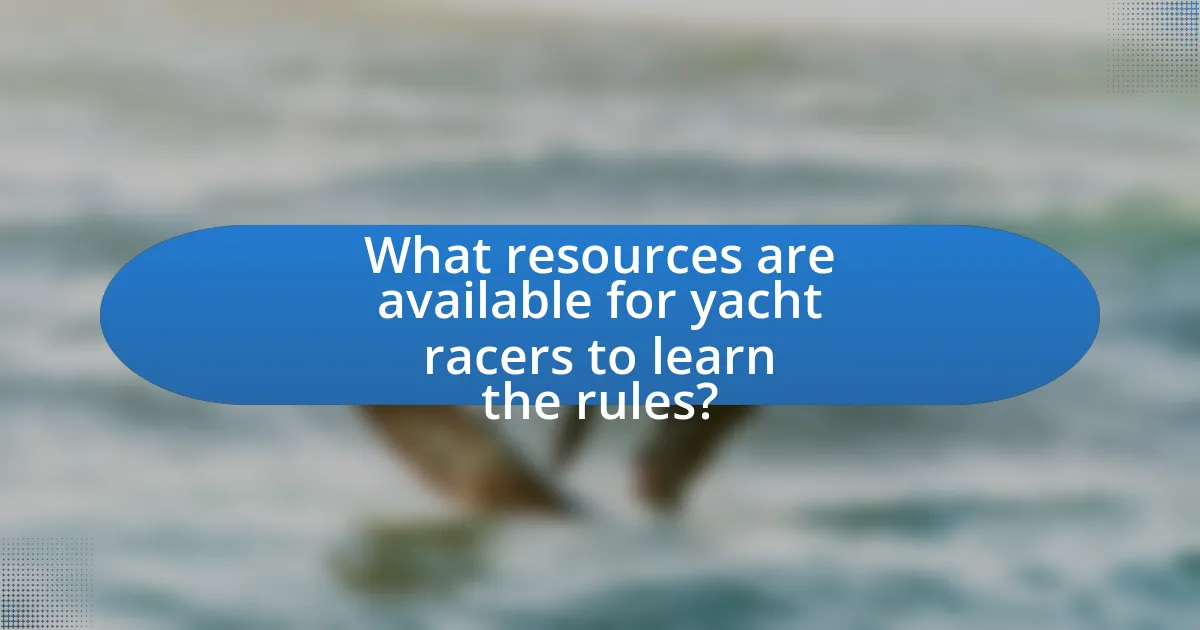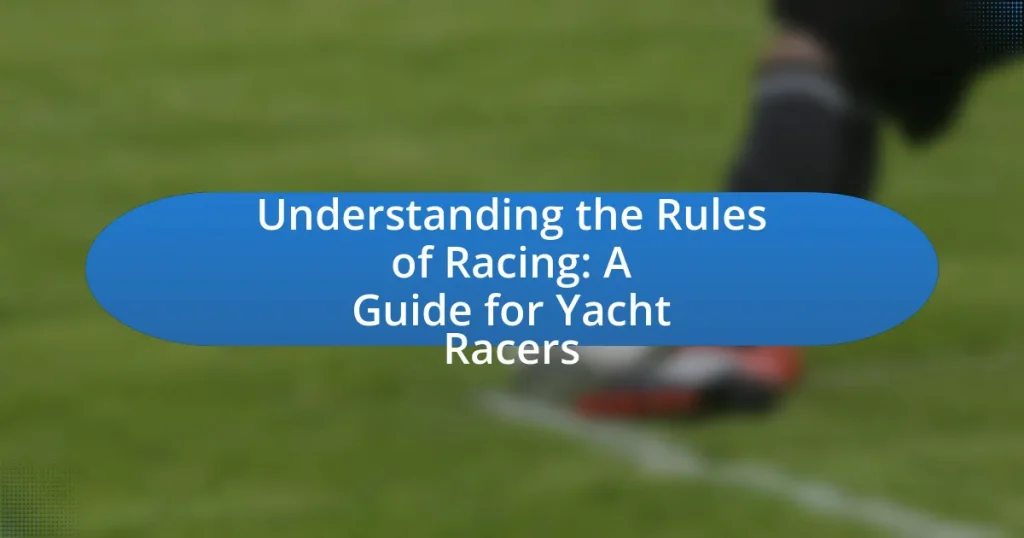The article “Understanding the Rules of Racing: A Guide for Yacht Racers” provides a comprehensive overview of the Racing Rules of Sailing (RRS), which govern yacht racing and ensure fair competition and safety on the water. It outlines fundamental rules such as right-of-way, starting procedures, and penalties, emphasizing their importance in shaping racing strategies and enhancing performance. The article also discusses the significance of understanding these rules for racers, the consequences of rule violations, and resources available for learning and applying the rules effectively. Additionally, it highlights best practices for racers to prepare for rule changes and remember key regulations during races.

What are the fundamental rules of yacht racing?
The fundamental rules of yacht racing are primarily governed by the Racing Rules of Sailing, which are established by World Sailing. These rules include the right of way, which dictates which boat must yield to another, and the obligation to avoid collisions, ensuring safety on the water. Additionally, rules regarding starting procedures, course navigation, and finishing requirements are critical for fair competition. For example, Rule 10 states that when boats are on opposite tacks, the one on port tack must keep clear of the one on starboard tack. These rules are enforced during races to maintain order and fairness, and they are regularly updated to reflect changes in the sport.
How do the Racing Rules of Sailing (RRS) govern yacht racing?
The Racing Rules of Sailing (RRS) govern yacht racing by establishing a standardized framework of rules that dictate the conduct of competitors, race officials, and the organization of races. These rules ensure fair competition by outlining the rights and responsibilities of sailors, including rules on starting, sailing the course, and finishing. The RRS is updated every four years by World Sailing, reflecting the evolving nature of the sport and addressing issues that arise in competitive sailing. For example, the RRS includes specific provisions for situations such as collisions, penalties, and protests, which are crucial for maintaining order and fairness during races.
What are the key principles outlined in the RRS?
The key principles outlined in the Racing Rules of Sailing (RRS) include fairness, sportsmanship, and the importance of following the rules to ensure safe and competitive racing. Fairness is emphasized through the requirement that all competitors adhere to the same set of rules, promoting equal opportunity. Sportsmanship is highlighted as a core value, encouraging sailors to respect their opponents and the spirit of competition. Additionally, the RRS establishes guidelines for conduct on the water, including the responsibilities of sailors to avoid collisions and to protest rule violations appropriately. These principles are foundational to maintaining integrity and safety in yacht racing.
How do the RRS apply to different types of races?
The Racing Rules of Sailing (RRS) apply to different types of races by providing a standardized framework that governs the conduct of all sailing competitions, including fleet races, match races, and team racing. In fleet races, the RRS ensures fair competition among multiple boats by establishing rules for starting, sailing the course, and finishing, which are crucial for maintaining order and safety. In match racing, the RRS emphasizes one-on-one competition, focusing on rules that dictate right-of-way and penalties, which are essential for determining the winner in direct confrontations. Team racing incorporates elements of both fleet and match racing, with the RRS adapted to facilitate strategic team tactics while ensuring compliance with racing regulations. The consistent application of the RRS across these formats promotes fairness and sportsmanship, as evidenced by their adoption in international competitions governed by World Sailing.
Why is understanding the rules crucial for yacht racers?
Understanding the rules is crucial for yacht racers because it ensures fair competition and adherence to safety protocols. Knowledge of the rules allows racers to make informed decisions during races, minimizing penalties and maximizing performance. For instance, the Racing Rules of Sailing, established by World Sailing, outline specific regulations that govern racing conduct, including right-of-way situations and penalties for rule violations. Familiarity with these rules can significantly impact a racer’s strategy and overall success in competitions.
How can knowledge of the rules enhance racing performance?
Knowledge of the rules enhances racing performance by enabling racers to make informed decisions that optimize their strategies and maneuvers. Understanding the rules allows competitors to navigate the course effectively, avoid penalties, and capitalize on opportunities presented by their opponents’ mistakes. For instance, familiarity with the Racing Rules of Sailing can help a sailor determine right-of-way situations, which can lead to advantageous positioning during a race. Additionally, a study by the International Sailing Federation indicates that teams with a strong grasp of the rules consistently outperform those who lack this knowledge, as they can better anticipate and react to the actions of others on the water.
What are the consequences of ignoring the rules?
Ignoring the rules in yacht racing can lead to disqualification from the race. Disqualification occurs when a competitor fails to adhere to established regulations, which can result in the loss of standings and potential penalties. For instance, the Racing Rules of Sailing explicitly state that violations can lead to a boat being scored as “DSQ” (disqualified), impacting both the individual race and overall series results. Additionally, repeated infractions may lead to further sanctions, including suspension from future events, as outlined by governing bodies like World Sailing.
What are the common rules that every yacht racer should know?
Every yacht racer should know the Racing Rules of Sailing, which govern the conduct of yacht racing. These rules include the right of way, which dictates that a boat with the wind on its port side must give way to a boat with the wind on its starboard side. Additionally, racers must understand the importance of mark rounding, where boats must pass marks on the correct side as specified in the sailing instructions. The rules also emphasize the need for fair sailing, prohibiting actions like colliding with other boats or gaining an unfair advantage through misconduct. These rules are established by World Sailing and are updated regularly, ensuring that all racers are aware of the latest regulations.
What are the right-of-way rules in yacht racing?
In yacht racing, the right-of-way rules dictate which vessel has priority in various situations to avoid collisions. The primary rule is that a sailing vessel under sail must give way to a power-driven vessel, while a sailing vessel on a port tack must yield to one on a starboard tack. Additionally, when two sailing vessels are approaching each other, the one on the starboard tack has the right-of-way. These rules are established by the Racing Rules of Sailing, which are governed by World Sailing, ensuring fair competition and safety on the water.
How do starting procedures work in yacht races?
Starting procedures in yacht races involve a sequence of actions that ensure a fair and organized start. Typically, the process begins with a preparatory signal, often a horn or flag, indicating that competitors should position themselves near the starting line. A countdown, usually five minutes, follows, during which yachts must remain behind a designated line until the start signal is given. The start signal, often a horn or flag, marks the official beginning of the race, and yachts must cross the starting line after this signal to be considered in the race. The rules governing these procedures are outlined in the Racing Rules of Sailing, which emphasize the importance of timing and positioning to avoid penalties for premature starts.

How do specific rules impact yacht racing strategies?
Specific rules significantly impact yacht racing strategies by dictating the permissible maneuvers and tactics that competitors can employ during a race. For instance, the Racing Rules of Sailing outline regulations regarding right of way, starting procedures, and penalties for rule violations, which directly influence how teams plan their approach to the racecourse. Teams must adapt their strategies to comply with these rules, such as optimizing their positioning to avoid penalties while maximizing speed and tactical advantage. Historical data shows that adherence to these rules can determine race outcomes; for example, in the 2013 America’s Cup, teams that effectively navigated the rules gained crucial advantages in both positioning and speed, demonstrating the critical role that understanding and applying specific rules plays in shaping successful racing strategies.
What strategies can be employed based on the rules?
Strategies that can be employed based on the rules of yacht racing include understanding right-of-way situations, optimizing sail trim for various wind conditions, and effectively communicating with the crew. Right-of-way rules dictate how boats should interact on the water, allowing racers to avoid penalties and collisions. For instance, knowing when to give way to another vessel can prevent disqualification. Optimizing sail trim enhances speed and maneuverability, which is crucial in competitive racing. Effective communication ensures that all crew members are aligned in their actions, particularly during maneuvers like tacking or gybing, which can significantly impact race outcomes. These strategies are essential for maximizing performance and adhering to the regulations of yacht racing.
How can racers use the rules to their advantage during a race?
Racers can use the rules to their advantage during a race by strategically interpreting and applying them to gain a competitive edge. For instance, understanding right-of-way rules allows a racer to position their yacht effectively against competitors, potentially forcing them into unfavorable positions. Additionally, racers can utilize rules regarding mark rounding to optimize their course, ensuring they take the shortest and fastest route. Knowledge of penalties and protests can also be leveraged; racers may avoid situations that could lead to penalties while being prepared to challenge unfair calls. This strategic application of rules has been shown to significantly impact race outcomes, as evidenced by numerous competitive sailing events where tactical rule interpretation has led to victories.
What are the tactical considerations for different wind conditions?
Tactical considerations for different wind conditions in yacht racing include adjusting sail trim, course selection, and crew positioning. In light winds, racers should maximize sail area and minimize drag by keeping sails full and using lighter crew weight to enhance boat speed. In moderate winds, optimal sail trim becomes crucial; adjusting the angle of sails to the wind direction can significantly improve performance. In heavy winds, reducing sail area is essential to maintain control and prevent capsizing; reefing sails and shifting crew weight to the windward side can help stabilize the boat. Historical data shows that successful racers adapt their tactics based on wind conditions, as evidenced by the 2013 America’s Cup, where teams adjusted their strategies dynamically to varying wind strengths.
How do penalties and protests work in yacht racing?
In yacht racing, penalties and protests are mechanisms to enforce compliance with racing rules. When a competitor breaches a rule, they may incur a penalty, which can include time penalties or disqualification, depending on the severity of the infraction. Protests are formal complaints lodged by a competitor against another, alleging a rule violation.
To initiate a protest, the protesting yacht must notify the race committee and the yacht being protested within a specified timeframe, typically within a short period after the incident. The race committee then conducts a hearing to evaluate the evidence and testimonies from both parties. The outcome can result in upholding the protest, imposing penalties, or dismissing the complaint.
These processes are governed by the Racing Rules of Sailing, which provide a structured approach to ensure fair competition and adherence to established regulations.
What are the common types of penalties in yacht racing?
Common types of penalties in yacht racing include disqualification, time penalties, and scoring penalties. Disqualification occurs when a yacht violates a rule and is removed from the race results. Time penalties involve adding a specific amount of time to a yacht’s finish time for infractions, such as failing to give way to another vessel. Scoring penalties affect a yacht’s overall score in the series, often applied for repeated rule violations. These penalties are outlined in the Racing Rules of Sailing, which govern competitive sailing and ensure fair play.
How should a racer handle a protest situation?
A racer should handle a protest situation by first remaining calm and composed. This approach allows the racer to assess the situation objectively. Next, the racer must gather all relevant information, including witness statements and any evidence that supports their case. According to the Racing Rules of Sailing, specifically Rule 61, the racer must inform the protest committee of their intention to protest as soon as possible, ideally within the time frame specified in the rules. This ensures that the protest is formally recognized and can be addressed appropriately. Additionally, the racer should prepare to present their case clearly and concisely during the hearing, focusing on factual evidence rather than emotions. This methodical approach is supported by the fact that successful protests often rely on clear communication and documented evidence, as outlined in the guidelines provided by the World Sailing.

What resources are available for yacht racers to learn the rules?
Yacht racers can learn the rules through several key resources, including the Racing Rules of Sailing published by World Sailing, which provides comprehensive guidelines on racing conduct. Additionally, many yacht clubs offer educational programs and seminars focused on the rules, while online platforms like the US Sailing website provide access to rule books, videos, and quizzes for self-study. Furthermore, books such as “The Racing Rules of Sailing Explained” by Bryan Willis serve as valuable references for understanding complex rules. These resources are widely recognized and utilized within the sailing community, ensuring that racers have access to accurate and up-to-date information on racing regulations.
Where can racers find official rulebooks and guidelines?
Racers can find official rulebooks and guidelines on the websites of governing bodies such as World Sailing and national sailing organizations. These organizations publish the Racing Rules of Sailing, which are updated every four years, and provide additional resources, including class-specific rules and local sailing instructions. For example, World Sailing’s website offers downloadable versions of the Racing Rules, ensuring that racers have access to the most current regulations and guidelines necessary for competitive sailing.
What online resources and communities support yacht racing education?
Online resources and communities that support yacht racing education include platforms like the Royal Yachting Association (RYA), US Sailing, and the International Sailing Federation (World Sailing). These organizations provide comprehensive educational materials, online courses, and forums for discussion among sailors. For instance, the RYA offers a range of online training modules covering racing rules and tactics, while US Sailing provides resources such as the Racing Rules of Sailing and educational webinars. Additionally, online communities like Sailing Anarchy and forums on websites like Cruisers Forum facilitate peer-to-peer learning and sharing of experiences among yacht racers.
How can attending racing clinics improve rule comprehension?
Attending racing clinics can significantly improve rule comprehension by providing hands-on experience and direct instruction from experts. These clinics often include practical scenarios where participants can apply racing rules in real-time, enhancing their understanding of complex regulations. For instance, clinics typically feature simulations of race situations, allowing sailors to see the implications of specific rules in action, which reinforces learning. Additionally, expert instructors can clarify nuances and answer questions on the spot, ensuring that participants grasp the intricacies of the rules more effectively than through self-study alone. This interactive learning environment fosters a deeper understanding of racing rules, ultimately leading to better decision-making during actual races.
What are some best practices for applying racing rules effectively?
To apply racing rules effectively, yacht racers should prioritize thorough knowledge of the rules, consistent communication among crew members, and proactive decision-making during races. Understanding the Racing Rules of Sailing, which are updated periodically by World Sailing, ensures that racers are aware of the latest regulations and can avoid penalties. Regular briefings before races foster clear communication, allowing crew members to understand their roles and responsibilities, which is crucial for compliance with rules. Additionally, making quick, informed decisions during races based on situational awareness can help avoid rule infringements and enhance overall performance. These practices are supported by the fact that adherence to rules not only promotes fair competition but also enhances safety on the water.
How can racers prepare for rule changes in upcoming seasons?
Racers can prepare for rule changes in upcoming seasons by staying informed about the latest regulations and actively participating in discussions with governing bodies. Engaging with official communications from organizations like World Sailing or national federations ensures that racers are aware of any modifications to the rules. Additionally, attending seminars or workshops focused on rule changes can provide valuable insights and practical applications. Historical data shows that racers who adapt quickly to rule changes often maintain a competitive edge, as seen in the 2021 America’s Cup, where teams that embraced new regulations improved their performance significantly.
What tips can help racers remember key rules during a race?
Racers can remember key rules during a race by using visual aids, practicing rule scenarios, and engaging in regular discussions about racing regulations. Visual aids, such as laminated cards with essential rules, can be placed on the boat for quick reference. Practicing various racing scenarios helps reinforce the application of rules in real-time situations, making them more memorable. Additionally, discussing rules with teammates fosters a shared understanding and reinforces memory through collaborative learning. These methods are effective because they engage different learning styles and promote active participation in the learning process.


